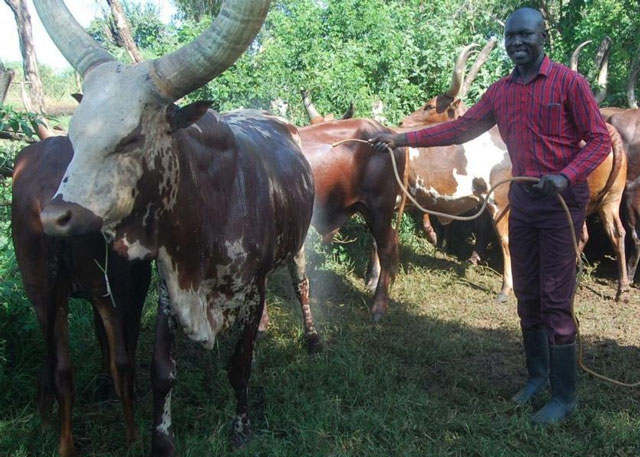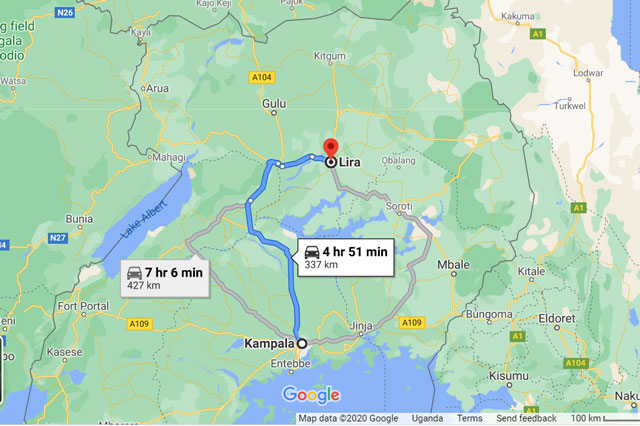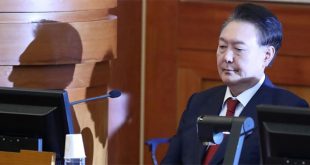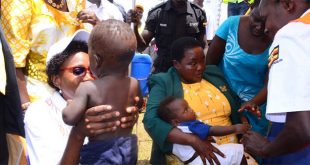
Lira, Uganda | THE INDEPENDENT | About 15 kilometers from Aduku, along Ikwera to Nambieso Sub County road, lies Ogwang-med-mac farm owned by Patrick Ogwang, a former office attendant, now model farmer.
Ogwang, who in the past worked as an office attendant in the office of the LC3 Chairman of Chawente Sub-county now owns a successful farm that is home to 192 head of Ankole cattle, 67 hybrid pigs and 43 sheep.
“During my service as an office attendant, my monthly salary was 69, 000 shillings, but because I wanted to invest and develop myself, I would faithfully save 40,000 shillings with Cooperative Bank Apac,” Ogwang narrates.
Over time, he was able to open up a small shop at Goi landing site along the shores of Lake Kwania.
Soon after this, the ever enterprising Ogwang joined a local youth’s group, which allowed him to hire small markets in his area. The money he reaped from this venture gave him the confidence to resign from his job and go full time into business.
However, Ogwang fondly recalls his investment in the shop as the springboard for most of his later success as a businessman and politician.
“My small investment helped me join politics: in 2006, I contested and won as the Sub-county Youth Counselor. In 2011, I won the sub-county LC3 seat before I retired from politics in 2016,” he added.
Humble beginning
In 2008, Ogwang decided to invest in livestock farming with seed capital of 1million shillings taken from his shop business.
“I started with 4 indigenous cattle, each costing 150,000 shillings. I spent 180,000 shillings on fencing the kraal, 120,000 shillings on insecticides for spraying and Shs 100,000 on paying for labour,” he says.
A few years later, his herd had grown to 102 cattle, each of which he sold at between 400,000 to 600,000 shillings, earning him a little profit.
However, Ogwang was not satisfied with what he felt was a thin profit margin from the sale of his cows, compared to the labor and investment that he had put into the business over the years.
”The indigenous breed was not giving me much profit because their quality was not that good, and although their numbers had increased to 102, I had to sell them off,” he said.
The decision to sell was prompted by a 2011 visit Ogwang made to President Museveni’s farm in Rwakitura where he fell in love with the Ankole breed of cattle.
“I sold off all 102 of my indigenous cattle for 26 million shillings. I topped that up with another 20 million shillings to make 46million which I used to buy 41 Ankole breed cattle,” he explained.

Strategic switch
Already a fairly seasoned cattle farmer at the time, Ogwang was strategic in his purchase.
“Most of the Ankole breeds that I bought were already pregnant, and so in a short time they were giving birth. Since they grow very fast, their numbers rapidly multiplied,” he said.
Ultimately, however, Ogwang says the switch to the more expensive Ankole breed was justified by the price they fetch on the market, compared to indigenous breeds.
For instance, he says, a big sized bull at his farm goes for between 2 to 3million shillings, while the small sized cows are sold at Shs 700, 000 to 800, 000.
His main clients are local livestock dealers who then sell the cattle in Arua District and South Sudan.
Ogwang also earns from selling milk from his cattle, which he says fetches him between 64,000 to 70, 000 shillings daily.
In total, Ogwang says he makes about 70 million shillings annually from livestock and milk sales, all of which he ploughs back into the business in order to expand it and improve milk production on his farm.
Today, Ogwang says he has no regrets about the investment path he took. With exception of the cattle he has sold over the years, Ogwang currently has 192 heads of cattle in his kraal, and believes that livestock farmers in general do better than crop growers, even during dry seasons.
Overcoming challenges
Nevertheless, the journey has not been plain sailing, and like all entrepreneurs, Ogwang has had to overcome several challenges. Prominent among them are: the volatile prices of insecticides; high labor costs and scarcity of grass feed for the cows during the dry season.
“I hope to set up an irrigation system to enable me plant artificial grasses that will promote the speedy growth of my livestock and ensure high milk production in all seasons,” the visionary farmer says.
Ogwang also plans to acquire and rear high-quality bulls for beef production.
“I want to be able to supply the major towns in Lango with beef.”
He is also working with the Kwania district authorities to improve on his breed by cross-breeding them with Friesians.
Making an impact
Ogwang employs seven permanent workers and occasionally hires locals from the surrounding community when required. Using proceeds from the farm, Ogwang established a privately owned school called “Obia Memorial Nursery and Primary School” to help cover the education gap in the area. The school is currently one of the leading primary schools in Kwania District.
Babra Akao, also a farmer neighboring Ogwang’s farm says livestock farming is a good investment but capital-intensive enterprise. She appealed to the government to extend restocking programs to areas where they have not reached in order to empower the common man.
“We were affected by the insurgency and by Karamojong rustlers around the 1980s. Government should compensate our lost cattle,” she said.
Another farmer, Okwir Bongoni Ojok, advised livestock farmers to be keen on implementing the best farm management practices if they are to enjoy ample returns on their investments.
***
URN
 The Independent Uganda: You get the Truth we Pay the Price
The Independent Uganda: You get the Truth we Pay the Price




I need contact details for any farmer who breeds Ankole cattle. I am interested on buying a few.
Please hook me up, when you got someone’s contact details selling Ankole cattle.
Hi, who can link me up with Ankole farmers please,
Iam from Kenya and I need few of Ankole cows.
Kind Regards.
Hy am Arthur I can supply you Ankole cows and mi contact is 0761375254
hi, how much is the male and female ankole cow?
I can